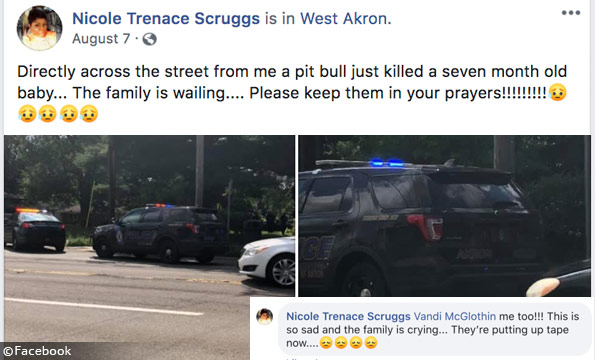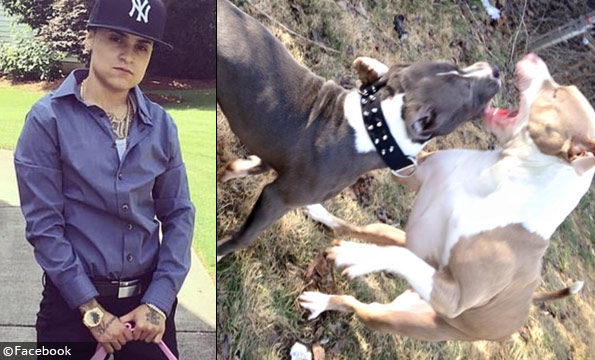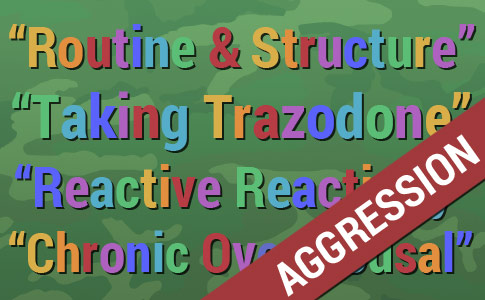| Aggression |
Mod-High |
Dog has "separation anxiety" - A term that can cloak severe aggression, like jumping out of a glass window. |
Link |
| Aggression |
Mod-High |
Dog has "kennel stress" or "shelter stress." |
Link |
| Aggression |
Mod-High |
Dog can be "pushy" with other dogs. |
Link |
| Aggression |
Mod-High |
Dog is "leash biting" or is a "leash biter." |
Link |
| Aggression |
Mod-High |
Dog is "grabby" with toys - Dog is resource guarding. |
Link |
| Aggression |
Mod-High |
Dog "needs proper introduction" to people. |
dog |
| Aggression |
Mod-High |
Dog has "poor kennel presence" or "poor kennel presentation" - Dog has kennel aggression. |
Link |
| Aggression |
Mod-High |
Dog has "barrier reactivity" - Dog has kennel aggression. |
Link |
| Aggression |
High |
Dog is an "orange dot" - A shelter marking system for the most problematic dogs; orange dots requires the help of the "Orange Dot Crew." |
Link |
| Aggression |
High |
If dog is a "red, blue or orange dot," it cannot be touched by any volunteer at the Austin Animal Center, a no-kill shelter. Unclear what shelter visitors are told. |
Link |
| Aggression |
High |
"Perfect dog" - Term always comes with "but" such as, it's a "perfect dog," but I can no longer trust it after it attacked me. |
Link |
| Aggression |
High |
We're trying to "reset dog back to his previous self." Decoded translates into extreme anxiety and resource guarding. |
Link |
| Aggression |
High |
Shelter will teach you "how to feed him so he doesn't feel protective of his food" - Dog is a resource guarder. |
Link |
| Aggression |
High |
Dog is "spunky" - Dog has aggressive flanking behavior. |
Link |
| Aggression |
High |
Dog likes to "body-crash" or is a "body-crasher." |
Link |
| Aggression |
High |
dog is "fence-fighting" or is a "fence fighter." |
Link |
| Aggression |
High |
Dog has "kennel aggression." |
Link |
| Aggression |
High |
Dog is "resource guarding." |
Link |
| Aggression |
High |
Dog is "food guarding." |
Link |
| Aggression |
High |
Dog is "alarm barking." |
Link |
| Aggression |
High |
Dog needs "transitional medication" - Behavioral medications that are sent home with adopter. |
Link |
| Aggression |
High |
Dog is "head shy." |
Link |
| Aggression |
High |
Dog is "fear reactive" that has "stolen many hearts" - The dog will attack people and pets and has been returned many times. |
Link |
| Aggression |
High |
Dog gets so excited, it "can't help but to jump on you." The dog is a potential a disaster. |
Link |
| Aggression |
High |
"Offensive aggression" - Describes aggression in a shelter dog that cannot be blamed on the shelter environment. |
Link |
| Aggression |
High |
Dog is a "ladies man" - The dog will attack men. |
Link |
| Aggression |
High |
Dog needs an "experienced owner." |
dog |
| Aggression |
High |
Dog came to shelter through "no fault of their own." |
dog |
| Aggression |
High |
"Defensive aggression" - Dog has no opportunity to choose flight, thus fighting is the only option. |
Link |
| Aggression |
High |
Dog is very "stressed being here" (at the shelter). |
Link |
| Aggression |
High |
Dog is "confused why she is here" (at the shelter). |
Link |
| Aggression |
High |
Dog "needs to decompress." |
Link |
| Aggression |
High |
Dog wants to become the "best dog we know she can be" - This means this dog is currently a disaster. |
Link |
| Aggression |
High |
Dog comes with "free lifetime behavior support" - This means this dog will always be a disaster. |
Link |
| Aggression |
High |
Dog is "strong willed" - Dog cannot be managed by an average dog owner. |
Link |
| Aggression |
High |
Dog has the "worst hard luck" story - Dog has been returned to the shelter 3 or more times. |
Link |
| Aggression |
High |
Dog is "still at the shelter" - Dog has been returned to shelter 3 or more times or is (urgent!) slated for euthanasia. |
Link |
| Aggression |
Very High |
Dog needs a "unicorn home." Dog is so animal-aggressive, anxious and a resource guarder that it can only tolerate a "fantasy" home with zero stimuli. Anti-anxiety medication is being sponsored for the dog. |
Link |
| Aggression |
Very High |
Dog "did not have one accident in my house." This indicates the dog had many "accidents," acts of aggression, previously in other homes. |
Link |
| Aggression |
Very High |
"Offensive aggression to humans" - Idiopathic aggression or low threshold dominance aggression. |
Link |
| Aggression |
Very High |
"Uninterruptible drive" - The dog will kill another dog on sight and will climb a fence to do it. |
Link |
| Aggression |
Scam Alert |
"Are you a Select family?" - Translates into "are you select enough" to own a problem dog? (Wine comparison hoax). |
Link |
| Aggression |
Scam Alert |
WCRASSelect Test - A "test" to determine which type of aggression is right for a family - (Wine comparison hoax). |
Link |
| Aggression |
Scam Alert |
Chardonnay - "Find guys scary" - Dog will attack men (Wine comparison hoax). |
Link |
| Aggression |
Scam Alert |
Riesling - "A hint of tartness, dog prefer no kids" (Wine comparison hoax). |
Link |
| Aggression |
Scam Alert |
"Unknown background" - Can indicate many things, including failing to tell adopter the dog has been returned 4 or 5 times. |
Link |
| Aggression |
Scam Alert |
Dog is a "staff pick" - Shelter is trying to offload a high-risk dog to the public. |
Link |
| Aggression |
Scam Alert |
Dog is a "staff favorite" - Shelter is trying to offload a high-risk dog to the public. |
Link |
| Aggression |
Scam Alert |
Dog is a "volunteer favorite" - Shelter is trying to offload a high-risk dog to the public. |
Link |
| Aggression |
Scam Alert |
Dog is a "velvet hippo" or "house hippo" - Shelter is trying to offload a high-risk pit bull to the public. |
Link |
| Animal Aggression |
Mod-High |
"Needs proper introduction" to dogs and cats. |
dog |
| Animal Aggression |
High |
Must be "only animal in home" - Dog will kill a dog or cat. |
Link |
| Animal Aggression |
High |
Must have a "low traffic, adult only home with no other pets" - Dog will kill a dog or cat. |
Link |
| Anxiety |
Mod-High |
Dog "needs to decompress." |
dog |
| Anxiety |
Mod-High |
Dog "needs time to warm up to new people." |
Link |
| Anxiety |
High |
Dog is "painting" - Dog is excretmenting all over the kennel, smearing it everywhere, spinning; "cage crazy." |
2018 APA5 |
| Anxiety |
High |
Dog is doing "arts and crafts" - Dog is excretmenting all over the kennel, smearing it everywhere, spinning; "cage crazy." |
2018 APA6 |
| Anxiety |
High |
Dog has "trust issues." |
Link |
| Anxiety |
High |
Dog has "PTSD." |
Link |
| Anxiety |
High |
Dog has "shelter anxiety" and "ongoing anxiety" |
Link |
| Anxiety |
Very High |
Dog is "vulnerable and apprehensive." Instead of fetching tennis balls, this dog destroys the ball then eats the pieces. |
Link |
| Anxiety |
Very High |
Dog is "kind of anxious" - Decoded translates into "extreme anxiety" even after "medication and behavior modification." |
Link |
| Anxiety |
Scam Alert |
Dog joined "elite #fosterwin club!" - Another gimmick "award." This dog has such extreme separation anxiety, his foster may be using a crate built for shipping "strong jawed" dogs in airplane cargo, upwards of $600 (CR-82 Compliant). |
Link |
| Cat Aggression |
Mod-High |
Dog needs a "dog-savvy cat." |
Link |
| Cat Aggression |
High |
Dog is "not cat-tested" - Dog could kill a cat. |
Link |
| Cat Aggression |
High |
Dog is "cat-selective" - Dog will kill some cats. |
dog |
| Cat Aggression |
Very High |
Dog is "waaayyy too interested in the furry creatures" - Dog will kill a cat. |
Link |
| Cat Aggression |
Very High |
Dog "doesn't like cats" - Dog will kill a cat. |
dog |
| Dog Aggression |
High |
The dog is "dog-reactive" - Dog-aggressive specific, as if it presents no danger to humans (redirecting onto a human, etc). |
Link |
| Dog Aggression |
High |
Dog "lacks self-confidence" - Decoded translates into dog has "dog aggression." |
Link |
| Dog Aggression |
High |
Dog was "kept in the bathroom" away from other dogs. |
Link |
| Dog Aggression |
High |
"Selective dog" behavior - Dog will kill some dogs. |
dog |
| Dog Aggression |
High |
Dog is "dog selective" - Dog will kill some dogs. |
dog |
| Dog Aggression |
Very High |
Dog is "reactive toward other dogs" - Dog will kill a dog. This dog's bite history was hidden from the adopter and was part of the CBS LA investigation into Orange County Animal Care. |
Link |
| Dog Aggression |
Very High |
Must be "only dog in home" - Dog will kill a dog. |
dog |
| Dog Aggression |
Very High |
Must be "only K9 baby in the house" - Dog will kill a dog. |
Link |
| Dog Aggression |
Scam Alert |
Merlot - Dog has "bold personality" and "dog savvy" - Dog is "dog selective" (Wine comparison hoax). |
Link |
| Dog Aggression |
Scam Alert |
Port - Dog will "turn their noses on dog parks" and believes in "moDOGamy" - one dog per family (Wine comparison hoax). |
Link |
| Dog aggression |
Scam Alert |
Dog is a "top dog trainee" - Shelter is trying to offload a high-risk dog to the public. "Floppy," is dog-aggressive, has a low children score and is too dangerous to be cat tested. |
Link |
| Drugged |
High |
Dog is taking Gabapentin - Anti-anxiety medication. |
Link |
| Drugged |
High |
Dog is taking Solliquin - Anti-anxiety medication. |
Link |
| Drugged |
High |
Dog is taking Trazodone - Anti-anxiety medication. |
Link |
| Escape Artist |
High |
Dog is a "runner" - Dog has a history of escaping. |
Link |
| Escape Artist |
High |
Dog has "great leaping ability" - Dog cannot be contained. |
Link |
| Failure to Test |
Mod-High |
Dog had a "Checkpoint" evaluation instead of an actual behavior assessment. |
2018 APA7 |
| Failure to Test |
Mod-High |
"I don't know" - A response to adopter's question of dog's behavior. |
Link |
| Fatal Attack Aggression |
Very High |
"Trigger stacking" - A fabricated term used by a professional to excuse a fatal dog mauling. |
Link |
| Handler Aggression |
High |
"Lacks self-confidence" - Decoded translates into dog has "aggression towards his person/handler." |
Link |
| Implusive Aggression |
High |
Must "limit his exposure to triggers" -- or the dog could explode into aggression. This dog did explode and severely attacked the author of the blog. |
Link |
| Implusive Aggression |
High |
Shelter will teach you how to get the "right routine down" - This translates into "limiting the dog's exposure to triggers." |
Link |
| Implusive Aggression |
High |
Dog needs "routine and structure" or "structure and consistency" - Both also translate into "limiting the dog's exposure to triggers," a list that could be exhaustive. |
Link |
| Implusive Aggression |
High |
Dog needs a "stable and structured" environment to stay "balanced." The 2019 advertisement omits that 8-year old "Bucky" had 4 different owners by 2012. |
Link |
| Implusive Aggression |
High |
Dog has had a "complicated road" - This is a "long stay" dog (over 60 days at the shelter), and indicates severe behavior problems, which the advertisement calls "all of his quirks." |
Link |
| Implusive Aggression |
High |
Dog has bad reactions to "loud noises and sudden movements." |
Link |
| Implusive Aggression |
Very High |
Dog has "toggle-switch" predatory aggression. |
Link |
| Implusive Aggression |
Very High |
Dog has impulsive "rage like" aggression. |
Link |
| Implusive Aggression |
Very High |
Dog has explosive, "disinhibited aggression." |
Link |
| Implusive Aggression |
Very High |
Impulsive aggression is "pathological." |
Link |
| Implusive Aggression |
Very High |
Dog has "lack of impulse control." |
Link |
| Implusive Aggression |
Very High |
Dog has "deficient impulse control." |
Link |
| Implusive Aggression |
Very High |
Dog has "deficient bite inhibition." |
Link |
| Implusive Aggression |
Very High |
Dog has "impulsive aggression" - Unpredictable aggression. |
Link |
| Implusive Aggression |
Very High |
Dog is "reactive" - Dog is aggressive and lacks impulse control. This dog killed a person hours after adoption. |
Link |
| Implusive Aggression |
Very High |
Dog is getting "more and more reactive." Kinks was part of the KVOA investigation into Pima Animal Care Center. The dog's kennel card only stated, "I need a dog introduction." |
Link |
| Implusive Aggression |
Very High |
Dog has "unpredictable aggression to humans." |
Link |
| Lacks basic obediance |
Mod-High |
Dog is still "learning some manners." |
Link |
| Lacks basic obediance |
High |
Dog "needs to learn manners." |
dog |
| Lacks basic obediance |
High |
Dog "can use some training." |
Link |
| Lacks basic obediance |
High |
Dog comes with "free obedience training." |
dog |
| Lacks Bite Inhibition |
Mod-High |
Dog exhibits "mouthiness." |
Link |
| Lacks Bite Inhibition |
Mod-High |
Dog is "mouthy" not aggressive. |
Link |
| Lacks Bite Inhibition |
Mod-High |
Dog has "persistent mouthing." |
Link |
| Over arousal |
Mod-High |
Dog has "bouncy play style." |
Link |
| Over arousal |
Mod-High |
Due to his "bounciness" children must be 8 years or older or dog is "too bouncy" for young children. |
Link |
| Over arousal |
Mod-High |
Dog is "rambunctious." |
Link |
| Over arousal |
High |
Dog is "overly-exuberant" - A term used by a senior state HSUS director after her dog killed a woman with a Level 6 bite. |
Link |
| Over arousal |
High |
Dog has a "happy, energetic tale" - dog hung self in kennel on collar; later tore her own cruciate ligament by kennel jumping. |
Link |
| Over arousal |
High |
Dog has "popping play style." |
Link |
| Over arousal |
High |
Dog is an "adventure buddy" or makes a "great jogging partner." |
Link |
| Over arousal |
High |
Dog needs to "work off my puppy energy." |
Link |
| Over arousal |
High |
Dog is "high energy." |
Link |
| Over arousal |
Very High |
Dog "can't be startled." |
Link |
| Over arousal |
Very High |
Dog knows the "agility course" - Dog has constant over arousal, jumping up and biting at staff. |
Link |
| Over arousal |
Very High |
Dog has "sudden over-arousal." |
Link |
| Over arousal |
Very High |
Dog is "chronically over-aroused." |
Link |
| Over arousal |
Very High |
Dog has "inability to self-dampen." |
Link |
| Over arousal |
Scam Alert |
Syrah - "Spicier than some" (Wine comparison hoax). |
Link |
| Stranger Aggression |
High |
Dog "lacks self-confidence" - Decoded translates into dog has "stranger aggression." |
Link |
| Stranger Aggression |
Very High |
"Stranger danger" - Dog will attack anyone visiting your home. |
Link |
| Uknown History |
Very High |
Dog "found roaming." |
Link |
|












